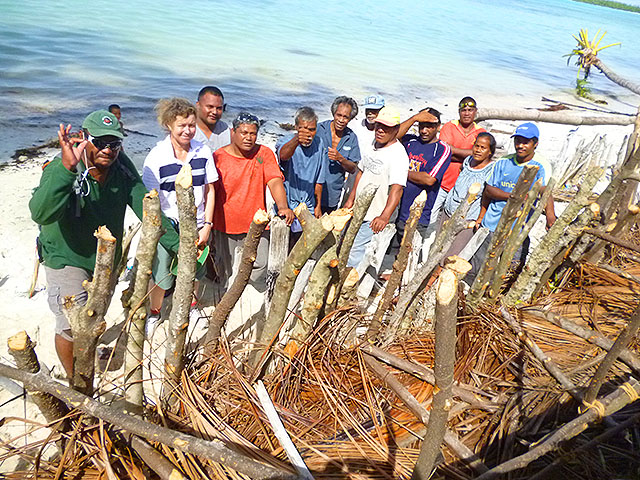
Climate Change Resilience
While beaches undergo a natural cycle of erosion and deposition over time, many beaches can erode and not recover, causing loss in island land area and beach width. In Kiribati, most of Abaiang atoll's sand beaches have been eroding, and this may be partly due to human impacts such as pigs tied to beach edge trees, trampling of beach vines and seedlings, and sand mining.
SPREP has developed a community guide for "Coastal Ecosystem-based Rehabilitation", which explains how to assess beach condition, decide on actions needed, and how to do rehabilitation. Methods include community education on beach values and damage, access control to allow vegetation recovery, beach vegetation planting, and brush barrier protection.

Staff from the Kiribati Government's Environment and Conservation Division with Dr Joanna Ellison from the University of Tasmania, demonstrated these techniques in villages of Tabontebike, Taneau and Tanimaiaki with support from community volunteers to undertake the work. Development of the guide has been funded by Australian Aid, and work on Abaiang atoll has been funded by the SPREP-USAID Climate Change Adaptation Partnership Project.
Healthy beaches can reduce wave energy impacting the island, and good beach vegetation can help reduce vulnerability of beaches to erosion. Local communities are an essential part of keeping beaches healthy and can use low cost, natural ways to make beaches stronger.
SPREP has developed a community guide for "Coastal Ecosystem-based Rehabilitation", which explains how to assess beach condition, decide on actions needed, and how to do rehabilitation. Methods include community education on beach values and damage, access control to allow vegetation recovery, beach vegetation planting, and brush barrier protection.

Photo: Brush barrier protection structure at Taneau village, Ab (Photo: Joanna Ellision/SPREP)
Staff from the Kiribati Government's Environment and Conservation Division with Dr Joanna Ellison from the University of Tasmania, demonstrated these techniques in villages of Tabontebike, Taneau and Tanimaiaki with support from community volunteers to undertake the work. Development of the guide has been funded by Australian Aid, and work on Abaiang atoll has been funded by the SPREP-USAID Climate Change Adaptation Partnership Project.
Healthy beaches can reduce wave energy impacting the island, and good beach vegetation can help reduce vulnerability of beaches to erosion. Local communities are an essential part of keeping beaches healthy and can use low cost, natural ways to make beaches stronger.
For more information please contact azarelm@sprep.org